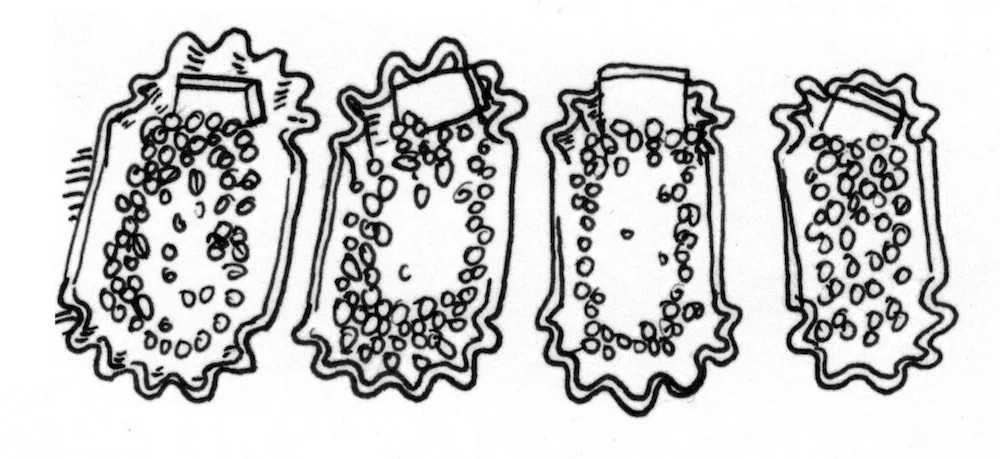How a Strong Offering Philosophy Beats “Purchasing Power”
By Ryan Brown
Author of Dear Coffee Buyer
A sentiment I hear often from buyers representing smaller roasteries is, “How can I compete with bigger buyers for the best green coffee? They have all the purchasing power!”
I’ve been at both the small (Ritual, Tonx) and the big (Stumptown, Blue Bottle, Peet’s) and I ask: How can they compete with you, small buyer? I have never encountered a more thoughtful buyer than the one who can purchase only a handful of coffees a year. A big buyer has to deal with a persistently huge appetite, and if you recall the times you’ve been famished, your discernment for quality tends to dip. It’s when you can’t eat too much that you become very, very picky.
Besides, “best” is a fairly useless term when considering what guides your green coffee purchases. As I discuss in Dear Coffee Buyer: A Guide to Sourcing Green Coffee: “Coffee buying is not a skill with linear, inevitable results, where two hypothetically “equal” buyers choose to buy the same coffee. Scores may be objective, but preference is not. A world with more proficient buyers is a world with greater availability of excellent, varied, coffee options.”
The most important thing that a buyer of any size can do is to establish an offering philosophy, something I cover in greater detail in the book:
When I began in specialty coffee there were two implicit but well-followed rules:
• You must offer representative coffees from the three major growing regions: Latin America, East Africa, and the Pacific Islands.
• You must offer a fistful of proprietary blends.
To this day, you can still see many of these rules followed in older establishments such as Peet’s and Starbucks. It seems wild now, but the third-wave pioneers mostly accepted these rules, with the slight tweak of replacing “representative” with “most pleasing” or something like that. A menu of thirty-one flavors was predictable and honestly represented the world’s spectrum of coffees. A roasting company distinguished itself almost entirely by the way it talked about coffee’s flavors, as expressed by some combination of national terroir and roast degree. By today’s standards, almost all roasters had a heavy foot on the gas pedal of the roaster. Those dark roasts and discussions of flavors, plus each company’s coffee-shop aesthetics, comprised the heart of the “brand.” It’s not that roasters felt they had no choice in this matter; it’s more that the idea of choice was precluded by these implicit rules.
A few optional origins produced exceptional quality at entirely reasonable prices. Some of the origins that were overpriced from a cup-quality:cost perspective, such as Hawaii and Jamaica, were nearly ubiquitous at the specialty cafés of the second wave. As late as 2010–2011, Kevin Knox, ex-buyer at Allegro and coffee-buying luminary, complained about roasters that weren’t offering the full lineup, nearly implying that it was a cheat (whether to customer expectations or to implicit rules, I am not sure) to exclude naturals or wet-hulled coffees from your menu.
Because I learned to buy coffee with no mentor and few understood expectations, I modeled the early menu at Ritual in 2007 in the same way that I saw Stumptown and Intelligentsia doing it, which is to say that I bought at least one coffee from every region and offered it nearly year round. Those two companies were pioneers of the third wave, and it seemed reasonable for me to first copy what they did, as their practices were the closest things to “instructions” I could find.
I broke the rules by accident initially, but as soon as I did, it was an epiphany. I had been traveling for weeks and miscalculated our consumption of Sumatra against our inventory, causing our roastery to run out. Sumatra was a staple of every third- wave menu at the time. I began going through the motions of replacing it. I contacted several brokers—traders who buy and sell coffee of various qualities—and asked for Sumatra spot samples (samples representing lots that are in domestic warehouses and available for immediate shipment to a roastery), roasted and cupped the samples, hemmed and hawed over the results, and finally made a decision: Ritual would no longer buy Sumatra.
By 2008, Ritual was building a reputation for clean, acidic coffees. I loved exotic flavors, but I wanted them to be true to the bean, not the result of zealous roasting or overwrought processing. At the time, if you had given a cup of Sumatra—a region that produces predominantly wet-hulled coffee—to a coffee taster and told her it was from Latin America, she’d have told you it lacked clarity of cup if she was diplomatic, or that it was dirty or defective if she was honest. If you then said, “Oops! I’m mistaken, it’s from Sumatra,” the coffee taster would recant and suddenly begin extolling the cup’s earthy, woody, dry characteristics. To me, the idea that different origins should be judged differently is foolish. How could I ever look at a Latin American producer again and tell him his coffee wasn’t up to snuff because it was earthy, woody or dry, while I was buying earthy, woody, dry coffee from Sumatra?
I couldn’t.
Instead of arranging for purchase of Sumatra, I talked with Ritual’s owner, Eileen, and convinced her that it was OK for us to not offer Sumatra. She asked me a few due diligence–type questions and then smiled and, with her ever-persistent entrepreneurial spirit, championed the decision. I afterwards heard her bragging about our decision to not offer Sumatra because it wasn’t up to the quality standards we had established. I was relieved that she was in agreement with me, thrilled that she was now using our decision to promote our green coffee narrative, and over the moon that I could—for a time—stop tasting wet-hulled coffee samples.
Now, the point of this story is not to tell you what your offering philosophy should be, though I’d selfishly be pleased if you stopped roasting wet-hulled and most naturally processed coffees. I want to make clear that you should have an offering philosophy, and you’ll be best off if it reflects your own taste preferences. The decision to stop offering wet-hulled coffees was a revelation for us at Ritual, and it felt like a huge weight was removed from our shoulders. I imagine that at this point not offering wet- hulled coffee is so deeply imbued in the ethos of Ritual that there would have to be a true revolution in wet-hulling for them to reverse course and begin offering it again.
The real revelation was not that we no longer had to offer Sumatra; it was that we didn’t have to follow any of the unwritten rules. Furthermore, your personal tastes do not have to be as simple as what flavors you favor in brewed coffee; they can also reflect more abstract preferences.
If you’re inclined to note that the grass is always greener on the other side, gaze on. It’s true! Bigger buyers absolutely have advantages, but so do you. Yes, they have purchasing power, and for many suppliers, it’s easier to work with fewer, bigger buyers. Bigger buyers also tend to have more satisfactory outlets for the few lots that don’t show up as expected. But step outside of your coffee head for a moment and ask yourself if your most memorable experiences, culinary or otherwise, come from the bigger or smaller brands.
Pick up a copy of Dear Coffee Buyer for more of Ryan's perspective and advice on green-coffee buying.


